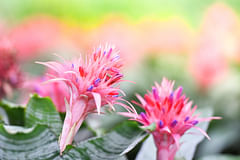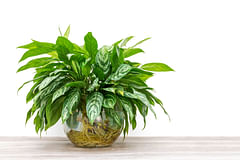How to take care of a Fern indoors
Ferns are beautiful plants with a lot of textures, shapes, and sizes. There are a lot of different ferns, each with their own characteristics. In this plant care guide, we're going to look at how to take care of your type of Fern.

Ferns are beautiful plants with a lot of textures, shapes, and sizes. There are a lot of different ferns, each with their own characteristics. Luckily, most ferns are quite similar when it comes to their care.
In this plant care guide, we're going to look at how to take care of your type of Fern. These are the topics we're going to look at in this plant care guide:
Let's dive right in and explore everything you should know to help your Fern thrive and make your house feel like a forest.
Watering your Fern

Watering is the most important part of taking care of a Fern. Your Fern loves to be in a moist environment. Ferns love to be in soil that's moist all the time and they don't do well if the soil is dry for too long.
Some ferns, like the Boston Fern, should be watered when the soil is dry to the touch. Other ferns, like the Maidenhair Fern or the Button Fern like to be in soil that's always moist.
Water your Fern until the excess water starts to drip out of the bottom of the pot. Let the pot drip for about 5-10 minutes, so your plant won't sit in a puddle of water.
If you notice that your plant is dropping leaves, you've either under or overwatered it. You'll know if you've underwatered it if you haven't watered your plant in at least a week. If you've watered your Fern in the past 1-4 days, you might have overwatered your plant. You can help the Fern by correcting your watering schedule.
Can I use tap water to water my Fern?
Many beginning plant owners are worried about using tap water for their plants. The high levels of chemicals in tap water could harm your plant. But, in my experience, deciding if you can use tap water for your plants is quite easy. If you can safely drink your tap water, you can use it for your plants too.
If your tap water contains high levels of minerals and chemicals, using filtered or distilled water can help prevent the build-up of these harmful elements and keep your fern healthy and vibrant.
Filtered water is a great option for watering your Fern as it can remove impurities and chemicals like chlorine, which can be harmful to plants. Filtering can also help remove excess minerals like calcium and magnesium, which can accumulate in the soil and cause damage to your Fern's leaves.
Distilled water is another good option since it's free of any minerals and chemicals. This won't harm your plant. However, some minerals in tap water are beneficial to your houseplant, so it's not a bad idea to use (room temperature) rainwater to give your plants the beneficial minerals that might not be in distilled water.
How do I know if I'm overwatering or underwatering my Fern?
When it comes to taking care of Ferns, figuring out the correct amount of water can be a bit challenging in the beginning. Watering your plant too much can be just as bad, if not worse, than watering it too little, so you have to find the right balance.
If your fern is getting too much water, its roots may be standing in a puddle of water and could start to rot. On the other hand, not giving enough water can cause the fronds to droop and turn brown.
A good way to determine if you're overwatering is to check the soil moisture. Stick your finger into the soil about an inch deep. If the soil feels soaked or mushy, you may be overwatering. Also, if you notice a puddle of water in the saucer under the pot, it's a sign that you're overdoing it.
On the other hand, if you notice the soil is bone dry and the fronds are drooping or becoming crispy, this could be a sign of underwatering. In this case, give your Fern a thorough watering.
If the soil is bone-dry, I recommend to bottom-water your plant. This will help the soil to absorb the moisture it needs, as bone-dry soil isn't great at absorbing moisture before it drains from the pot.
Sunlight for your Fern
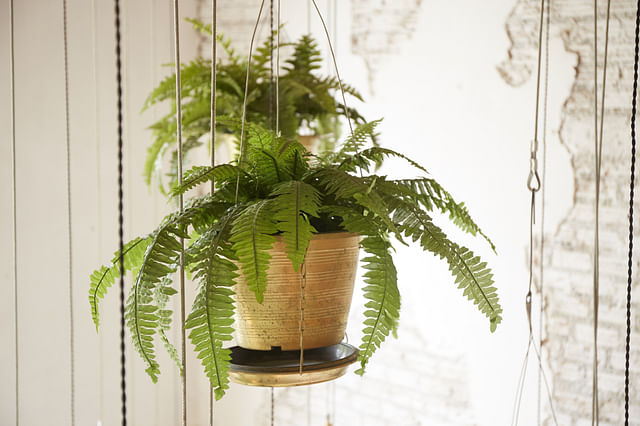
The second most important thing for your Fern is sunlight exposure. When you place your Fern in a spot that has the perfect sunlight exposure, you'll see your plant become happier and healthier.
Your Fern grows best in a spot that has indirect sunlight exposure. Indirect sunlight means that your plant doesn't get any direct sunlight on its leaves through a window. Direct sunlight will leave burn marks on the Fern or make its environment too warm for it to be happy.
The perfect place for your Fern is a spot in the middle of a room with a south or west-facing window, where it doesn't get any direct sunlight. You can also put your ferns in a room with a northern or eastern-facing window, as this light is weaker.
If you have an Asparagus Fern, pay attention: Your plant isn't actually a fern and needs bright, direct sunlight to be happy.
You can read more about the type of sunlight each direction gives you in "Does the sunlight direction matter for your houseplant?".
Where should I place my Fern to make sure it gets enough sunlight?
Ferns are known for their love of indirect sunlight, and they thrive in bright, indirect light. If possible, try to place your Fern in a location that gets bright, filtered light, such as near a north-facing window. This will help your Fern get the necessary light to grow and flourish.
However, be mindful of the amount of light your Fern is getting. If the leaves start to wilt or turn brown, they may be getting too much direct light. Similarly, if the leaves become yellow or pale, they may not be getting enough light.
If you're not sure where to place your Fern, you can always experiment with different locations until you find the perfect spot.
Sunlight exposure for your Fern in the winter
In the winter, the sun isn't as strong and is lower in the sky during the day. This means that there is less sunlight coming in through the windows and your house is darker during the day.
This also means that you should move your Fern closer to windows to give it some extra sunlight exposure. During the growing season (spring and summer) this sunlight is often too harsh, but it's fine during the winter.
How can I protect my Fern from direct sunlight during the hot summer months?
Protecting your Fern from direct sunlight during the hot summer months is essential to make sure it survives and grows. Ferns are low-light plants that thrive in damp, shaded, and cooler environments. Hot and dry conditions can cause their delicate leaves to wilt, dry out, and even die.
Here are some tips to help you protect your Fern from direct sunlight during the hot summer months:
- Move your Fern to a shaded area: During the hot summer months, it's best to move your Fern to a shaded area that receives indirect sunlight. This protects it from the heat of the sun to prevent drying out.
- Use a sheer curtain: You can also use a sheer curtain or shade cloth to spread out the direct sunlight. This will help reduce the intensity of the sunlight and protect your Fern from harm.
- Misting: Regularly misting your Fern's leaves can help keep them cooler and hydrated in hot and dry conditions. This will help prevent them from drying out and becoming damaged.
- Watering: It's important to keep your Fern moist, but not waterlogged. Watering in the early morning or late evening when the sun is less intense helps your Fern to absorb moisture more easily.
In the next section, we're going to look at the ideal temperature range for the average fern.
Temperature requirements for your Fern
A Fern is a perennial, which means it's a tough plant that lives for multiple years. Ferns prefer colder temperatures. During the day it shouldn't ideally be warmer than 24 degrees Celsius (75 F) and during the night it should ideally stay below 15 degrees Celsius (60 F).
The temperature in an average house is usually slightly too warm for a Fern, so it's a good idea to find a colder spot in your house for this plant. Because your Fern likes colder areas, it's important to keep it away from radiators, vents, and direct sunlight. These heat sources dry your Fern out too much too quickly and will slowly, or sometimes not so slowly, kill your Fern.
Humidity levels for your Fern

Creating the ideal humidity level for your Fern is important to make sure it stays happy for a long time. Before we explore the methods to achieve the right humidity, it is important to understand why humidity is so important for ferns.
Ferns are native to tropical and subtropical regions where the humidity is high. They have evolved to thrive in these conditions and require a high level of moisture to survive. Without this level of humidity, Ferns can dry out and wilt, leading to stunted growth and even death.
Ferns thrive in a humidity range of 40% to 60%. This level of moisture keeps them from drying out without encouraging fungal growth. Remember, humidity above 60% can lead to the development of harmful mildew and molds that can affect your ferns.
On the other hand, if the humidity level is above the recommended range, you may need to reduce the humidity. You can do this by improving air circulation or creating more space between Ferns.
To make sure your Ferns have the perfect level of humidity, you can use a hygrometer to measure the humidity. We will go over different methods of raising humidity levels in more detail in the next section.
How can I create the right humidity level for my Fern?
So ferns like a higher humidity growing environment, but how do you create this? There are several ways to achieve this, and some of them are incredibly easy and cost-effective.
- Group your Fern with other plants: When plants are grouped, they create a natural microclimate that increases humidity.
- Using pebble trays: You can easily make your humidity/pebble trays by filling a shallow container with pebbles or stones and then adding enough water to cover the bottom of the container. Place your potted Fern on top of the pebbles, making sure that the water doesn't touch the pot's bottom. The water will evaporate slowly, creating a gentle and consistent humidity level for your Fern.
- Mist your Fern regularly: This is a simple but effective way to increase the humidity around your plant. Use a spray bottle to mist the Fern's leaves with water once or twice a day.
- Place a humidifier in the same room as your fern: Humidifiers add moisture to the air, which can be beneficial for both your Fern and your respiratory health.
Raising the humidity around your plants is not just good for your fern, but other plants will also like the added moisture.
The perfect soil for your Fern
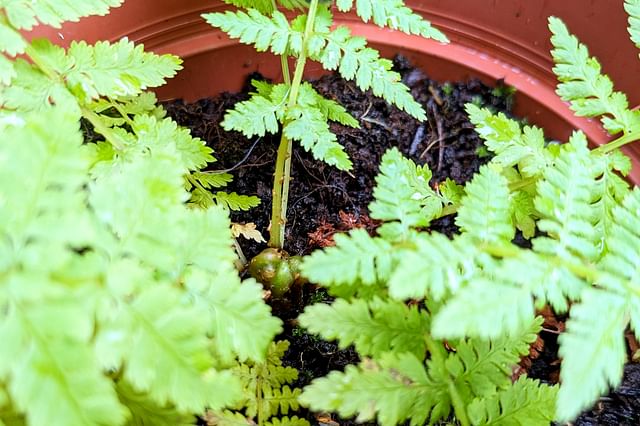 You've already learned so much about taking care of your Fern! Let's look at the best type of soil to help your Fern be happy and healthy.
You've already learned so much about taking care of your Fern! Let's look at the best type of soil to help your Fern be happy and healthy.
Earlier in this plant care guide, we discovered that your Fern loves to be in a moist environment, so we'll need soil that can retain moisture for a few days. While Ferns do require specific growing conditions, you can successfully plant them in regular potting soil.
To make sure your Fern has the healthiest growth, it's important to choose high-quality potting soil that will retain moisture and provide adequate drainage. Some potting soils are specially formulated for Ferns and other moisture-loving plants, which may be a good option if you're looking to give your Fern an extra boost.
You can also mix your own potting soil by getting general indoor potting soil and adding peat moss and some sand to it. This will help to retain more moisture, but also provides drainage and keeps the soil airy. When planting your Fern, be sure to select a pot with drainage holes to allow excess water to escape.
Fertilizing your Fern
Ferns, like any plant, need the right nutrients through fertilization to promote healthy growth and prevent nutrient deficiencies. Each fern species is slightly different, but their fertilizing needs are quite similar, so you can apply these tips to any fern you're taking care of.
A Fern is a fast-growing plant and needs to be fertilized regularly to support this growth. As a general rule of thumb, you can help your Fern thrive by fertilizing it with liquid fertilizer once per month during spring and summer. Over-fertilization can lead to burnt leaves and damage to the plant's roots.
When you purchase a brand-new bag of soil from the garden shop, it's most likely filled with fertilizer for the first 100 days. So when you repot your Fern or have just bought a Fern, you won't have to feed your plant for the first 100 days. After these 100 days, you will have to fertilize your houseplant to keep it strong and healthy.
You can read more about which fertilizer is best in "What is the best type of fertilizer for houseplants?".
Fertilizing your Fern in the winter
In the winter, when your Fern is dormant and it's not growing (as quickly), you shouldn't fertilize your plant. Your Fern won't use the fertilizer and it'll stay behind in the pot. This will make the soil salty and that will make it a tough place for your plant to grow.
For the best results, you shouldn't fertilize your Fern between the end of September and the beginning of March. In March, when spring starts and it's getting warmer, you can start to fertilize your Fern again.
Propagating a fern
If you love Ferns and want to propagate them to create new plants, you're in luck! Ferns are relatively easy to propagate, and you can have a bunch of new Ferns in no time. Here are some tips to help you propagate your Ferns successfully.
The best time to propagate Ferns is during the spring or early summer. This is when the Ferns are actively growing and have plenty of energy to put into new growth.
You can usually propagate a fern in 2 ways: harvest spores from the underside of the leaves (follow this picture guide) or propagate them by division.
If your Fern can be propagated by division, start by removing it from its pot and gently separate the roots. Make sure each division has its own root system and some foliage. Plant each division in its own pot and water well.
If your Fern can be propagated from spores, place a piece of paper under the fronds of the Fern and wait for the spores to fall onto the paper. Collect the spores and plant them in a pot with a mixture of peat moss and sand. Cover the pot with a plastic bag and wait for the spores to germinate.
Whether you're propagating by division or spores, make sure to keep the soil moist. Ferns love moisture, and propagating them takes a bit of patience. Keep the soil moist, but not waterlogged, and wait for the new growth to appear.
Common Fern issues and pests
Even with the best care, your Fern may run into some common issues and pests. Let's look at these issues and find out how to effectively tackle them to ensure your Fern remains healthy and vibrant.
Overwatering
Ferns love moisture, but too much water can lead to root rot and fungal growth. Make sure to let the soil dry out partially between waterings and avoid keeping the plant in a saucer filled with water.
Dry air
Dry air can cause Ferns to dry out and wilt. To prevent this, mist your Ferns regularly or keep a humidifier nearby. You can also place a tray of water near the plant to increase moisture in the air.
Scale insects
Scale insects can attach themselves to the leaves and stems of Ferns and cause damage. The damage can include wilting or yellowing leaves and stunted growth. To treat them, wipe the plant down with a cloth soaked in rubbing alcohol or use an insecticide labeled for use on indoor plants.
One of the easiest ways to identify scale insects is by looking for small, oval-shaped bumps on the undersides of the fronds.
Mealybugs
These pests look like small white bugs and can cause stunted growth and leaves to yellow and drop. To get rid of them, use a cotton swab dipped in rubbing alcohol to remove them from the plant or use an insecticide labeled for use on indoor plants.
These pests can be found on any part of the fern. You can usually find them by looking for insects with a large, cotton-like waxy coating. Mealybugs also excrete a sticky substance called honeydew, which can attract ants.
Spider mites
Spider mites can cause leaves to turn yellow and become speckled with white and yellow dots. To treat them, use a spray bottle filled with water and a few drops of dish soap to spray the plant and wash off the mites. You can also use an insecticide.
To identify spider mites, look for fine webbing on the plant, tiny dots moving on the leaves, and leaves that appear speckled or discolored. Spider mites thrive in hot and dry conditions, so be sure to keep your plants well-watered and misted.
Remember to inspect your Fern regularly for any signs of pests or issues, and take action as soon as possible to keep your plant healthy and beautiful.
Is your Fern toxic for pets?
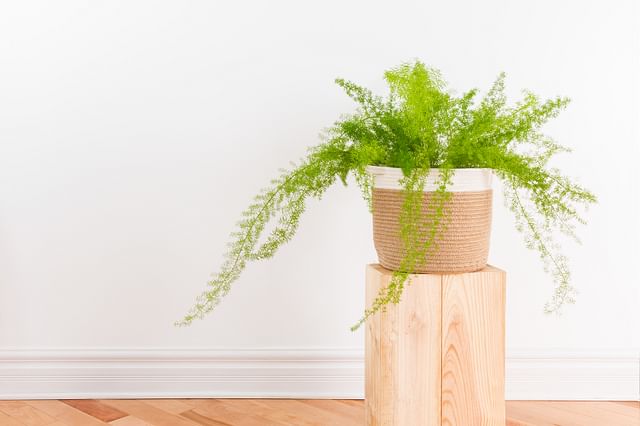
Some plants are toxic and should be kept away from pets and small children. You might ask yourself if your Fern is toxic to your pets and small children.
The Fern is a group of plants that on average aren't very toxic to pets and people, but there are a few Ferns that are toxic. The popular Asparagus Fern (emerald feather, emerald fern, sprengeri fern, plumosa fern, or lace fern) is toxic to your cats and dogs. When your pet eats this plant, they can start to vomit, have diarrhea, and get abdominal pain. If your pet has eaten the Asparagus Fern, make sure to call your veterinarian immediately.
Popular ferns like the Boston Fern (Nephrolepis exalta bostoniensis) are non-toxic to cats and dogs.
Winterizing a fern

Taking care of indoor Ferns in the winter is essential to maintaining their beautiful green foliage throughout the cold season. To winterize your indoor Fern, there are a few specific care tips to keep in mind.
Make sure your Fern is in a spot with enough light and humidity. Indoor heating during winter can dry the air, damaging your Fern's delicate fronds. Use a humidifier or place a water tray nearby to maintain moisture levels. Avoid placing your Fern near drafty windows or doors causing temperature drops.
To winterize your indoor Fern, pruning is crucial. As winter gets closer, your Fern may slow down its growth, which is normal. Notice any yellow or wilted older fronds? Just cut them back to the base. This helps your Fern conserve energy and nutrients for spring's fresh growth.
Lastly, pay attention to how much you are watering your Fern during the winter months. The soil in your Fern's pot may take longer to dry out during the winter, so be sure not to overwater it. Be sure to check the soil's moisture level before watering and only water when the top inch or two of soil feels dry to the touch.
Don't be discouraged if your Fern experiences some yellowing or shedding during this time – it's a natural response to the changing season.
Conclusion
In this plant care guide, we've looked at how to take care of your Fern. We've looked at how you can water your Fern, the perfect sunlight exposure, the best soil for your Fern, how to best fertilize Ferns, and whether your Fern is toxic for pets and kids.
Ferns are a great way to make your house feel more like a forest, add some texture to your house with their complex leaves, and serve as a great piece of decoration. If you have pets, make sure to check if your specific Fern is toxic or not, and take measures to protect both your pets and your Fern.
Thank you for reading this post! I hope it helps you to keep your plants healthy and beautiful! If you're looking for more guides on specific plants, you can always request a plant guide to get a guide for the plant you have trouble with.
Test your plant care knowledge
Quiz completed!
Want to learn more? Sign up for my newsletter to receive free tips in your inbox!
Sign up now!














